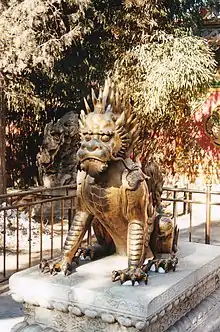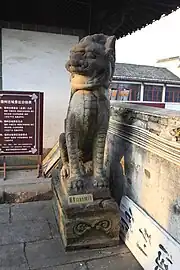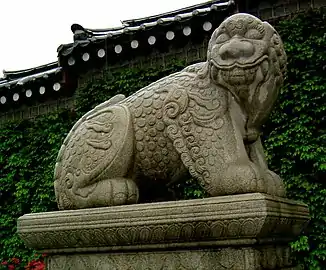| Xiezhi | |||||||||||
|---|---|---|---|---|---|---|---|---|---|---|---|
 | |||||||||||
| Chinese name | |||||||||||
| Traditional Chinese | 獬豸, 獬豸 | ||||||||||
| Simplified Chinese | 獬豸 | ||||||||||
| |||||||||||
| Vietnamese name | |||||||||||
| Vietnamese alphabet | giải trãi | ||||||||||
| Chữ Hán | 獬豸 | ||||||||||
| Korean name | |||||||||||
| Hangul | 해태 | ||||||||||
| Hanja | 獬豸 | ||||||||||
| |||||||||||
| Japanese name | |||||||||||
| Kanji | 獬豸 | ||||||||||
| Hiragana | かいち | ||||||||||
| |||||||||||
| Part of a series on |
| Chinese folk religion |
|---|
 |
The xiezhi (獬豸[lower-alpha 1]; xièzhì) is a mythical creature of Chinese origin found throughout Sinospheric legends. It resembles an ox or goat, with thick dark fur covering its body, bright eyes, and a single long horn on its forehead. It has great intellect and understands human speech. The xiezhi possesses the innate ability to distinguish right from wrong, and when it finds corrupt officials, it will ram them with its horn and devour them. It is known as a symbol of justice.
History
According to legend, the xiezhi, was a single-horned sheep or goat[lower-alpha 2] which had power to divine the guilt or innocence of a person. Gao Yao, the minister of justice for the legendary Emperor Shun employed the beast during criminal proceedings, and he would command the sheep to ram (head-butt) the accused. The beast would ram the guilty, but spare the innocent. The account appears in Wang Chong, Lunheng (80 AD).[7][1][2]
In the same work (Lunheng), the legend is prefaced the remark that public offices are painted with the images of the beast and the minister.[2][1]
As a symbol of traditional Chinese law, xiezhi has been promoted by the Chinese dynasties. The judicial hat (法冠) was also referred to as the xiezhi after the mythical sheep/ox.[8] The xiezhi hat was part of the attire of censors (yushi) into the 8th century during the Tang period, especially for an impeachment trial.[9]
Legend has it that during the Spring and Autumn period and the Warring States period, King Wen of Chu once obtained a xiezhi and put its image on his head, and then the xiezhi crown became a fashion in the State of Chu. Law enforcement officials in the Qin dynasty also wore such crowns, as did the Han dynasty, which inherited the Qin system. By the Eastern Han dynasty, images of the xiezhi became an indispensable ornament in the Xie Men, and the XieZhi crown was titled on the law. Therefore, law enforcement officials were called xiezhi.
Mentions of the xiezhi in Chinese literature can be traced back to the Han dynasty. "Rhapsody on the Imperial Park" (上林賦), Sima Xiangru mentions the xiezhi 解豸/解廌 "sagacious stag" among the prey in the year-end barricade hunt staged by the Son of Heaven.[10][11][12] Scholar Yáng Fú (杨孚)[lower-alpha 3] described the xiezhi 獬豸 in his treatise Yiwu Zhi as a "righteous beast, which rams the wrongful party when it sees a fight and bites the wrongful party when it hears an argument".[13] It is described in the Shuowen Jiezi as being "a cattle-like beast with one horn; in ancient times. It settled disputes by ramming the party at fault".[14]
As an inherently just beast, the xiezhi was used as a symbol of justice and law. The Censorate of the Ming and Qing eras, who were responsible for the monitoring of the civil service, wore the xiezhi as a badge of office. Among the common folk, the image of the xiezhi was believed to dispel evil spirits; a xiezhi might be carved on a lock to frighten off evil spirits. Similarly, military policemen of the Republic of China wear badges bearing the xiezhi and it is engraved on the gavels in the law courts of the People's Republic of China.
In 2022, a species of prehistoric giraffoid artiodactyl from early Miocene China, Discokeryx xiezhi, was named after the xiezhi in reference to a single bony plate on top of its skull which bore a resemblance to the horn of the mythical creature.[15]
In other places
Japan
In Japan, it is known as kaichi (獬豸), also sometimes referred to as a shin'yō (神羊, lit. 'divine sheep'). The kaichi is described as similar to a lion with one horn on the top of its head.[16]
Korea
The xiezhi is known as haetae (Korean: 해태) in Korea. According to Korean records, the haetae has a muscular leonine body covered with sharp scales, a bell in its neck, and a horn on its forehead. It lives in the frontier areas of Manchuria.[17]
In Joseon-dynasty Korea, the haetae was believed to protect against fire disasters. Sculptures of haetae were used in architecture (for example, at Gyeongbok Palace) to ward off fire. A cartoon haetae named Haechi is the city mascot of Seoul.
In English, the haetae may be called "the unicorn-lion."
Gallery
 A xiezhi in Anhui Province, China
A xiezhi in Anhui Province, China A haetae at a Korean palace
A haetae at a Korean palace
See also
Notes
- ↑ Other variants are 解豸, 解𧋈, 獬廌, 解廌, 觟𧣾, 觟䚦
- ↑ Given as "one-horned sheep" (Chinese: 一角之羊; pinyin: yījiǎo zhī yáng) in the original Chinese. Forke rendered this "the monoceros [hsieh-chai] is a goat with one horn",[1] Karlgren as " kie-chai is a ram with one horn";[2] Karlgren and Forke read 觟𧣾/獬豸 as hsieh-chai and kie-chai respectively, but hsieh-chih is the Wade-Giles romanization according to references otherwise consulted.[3]
- ↑ Not to be confused to the official Yáng Fù (楊阜) who flourished during the late Eastern Han and Cao Wei eras
References
- 1 2 3 Wang Chong (1962) [1907], "Ch. XXIX: Auguries Verified (Shih-ying)", Lun-hêng:Part II. Miscellaneous Essays of Wang Ch'ung, Forke, Alfred. tr. (2 ed.), New York: Paragon Book Gallery, p. 321
- 1 2 3 Karlgren, Bernhard (1946), "Legends and Cults in Ancient China", Bulletin of the Museum of Far Eastern Antiquities (18): 261, 324, JSTOR 40379201
- 1 2 Ssu-ma Ch'ien (2020), The Grand Scribe's Records, Volume X, Nienhauser, William H. tr., Indiana University Press, p. Endnote 208, ISBN 9780253056795
- ↑ Wang Chong 王充 (nd) [c. 85], "Shihying, chapter 52" 是應篇第五十二, Lunheng 論衡 [Discourses in the Balance] (in Chinese) – via Wikisource,
儒者說云:觟𧣾者、一角之羊也,性知有罪。皋陶治獄,其罪疑者,令羊觸之。有罪則觸,無罪則不觸。斯蓋天生一角聖獸,助獄為驗,故皋陶敬羊,起坐事之。此則神奇瑞應之類也。
- ↑ Wang, Tao [in Chinese] (1983) [1937], Jiweiju xiaoxue jinshi luncong 微居小學金石論叢/积微居小学金石论丛, Beijing: Zhonghua shuju, pp. 82–83
- ↑ Wang, Tao (2007), "Ritual Animals: Colour and Meaning (Part 1)", Bulletin of the School of Oriental and African Studies, University of London, 70 (2): 339, n132, JSTOR 40379201
- ↑ Wang Chong, Lunheng (in Chinese),[4] cited by Yang (1983)[1937],[5] cited as source on xiezhi by Wang Tao (in English).[6]
- ↑ Cui Hao(崔浩 d. 450), cited in the annotative work Shiji Suoyi ("Seeking the Obscure in the Grand Scribe's Records").[3]
- ↑ Chen, Xi (2022), A Study of Criminal Proceeding Conventions in Tang Dynasty, Shi, Guang. tr., Springer Nature, pp. 134–135, ISBN 9789811630415
- ↑ "Account of Sima Xiangru", in Sima Qian, Shiji (91 BCE). quote: "於是乎背秋涉冬,天子校獵。…… 弄解豸"
- ↑ "Account of Sima Xiangru A", in Book of Han (111 CE), quote: "於是乎背秋涉冬,天子校獵。…… 弄解廌"
- ↑ Sima Xiangru, "Fu on the Imperial Park" (translated by David Knechtges) (2008). in How to Read Chinese Poetry: A Guided Anthology edited by Cai, Zong-Qi. quoted: "And then, as the year turns its back on autumn and edges into winter, the Son of Heaven stages the barricade hunt. [...] Paw the sagacious stag. p. 67-68"
- ↑ Records of Strange Things (異物志) in Court Advisor Yang's works (楊議郎著書). quoted: "東北荒中有獸名獬豸一角性忠見人鬥則觸不直者聞人論則咋不正者" p. 27-28 of 980. Scanned by Chinese Text Project
- ↑ SWJZ, "Radical 𢊁" quote: "𢊁:解𢊁,獸也,似山牛,一角。古者決訟,令觸不直。"
- ↑ Pennisi, Elizabeth (2 June 2022). "This ancient giraffe relative head-butted rivals with an 'amazing sexual weapon'". Science. Science. Retrieved 2 June 2022.
- ↑ Gould, Charles (2009). Mythical Monsters. BiblioLife. pp. 357–359. ISBN 0-559-10836-2.
- ↑ An Illustrated Guide to Korean Culture - 233 traditional key words by The National Academy of the Korean Language